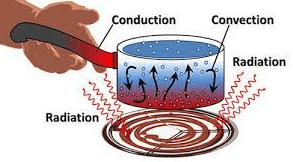Difference between conduction, convection and radiation
 There are three modes of heat transfer, conduction convection, and radiation. In the process of conduction heat transfer from a hot body to the cold body due to free electrons.In convection heat transfer due to the actual movement of molecules, While in radiation heat transfer in the form of electromagnetic waves.
There are three modes of heat transfer, conduction convection, and radiation. In the process of conduction heat transfer from a hot body to the cold body due to free electrons.In convection heat transfer due to the actual movement of molecules, While in radiation heat transfer in the form of electromagnetic waves.
There are three different ways of heat transfer. If you learn the difference between conduction, convection, and radiation, then you are in the right place. So, stay with us for a few minutes.
| Conduction | Convection | Radiation |
| Heat transfer by conduction is the process in which heat transfer from the hot body to the cold body due to free electrons. | Convection heat transfer is the process in which heat transfer in fluids due to the actual movement of molecules. | Radiation is the process of heat transfer in which heat transfer without any medium or directly. |
| It occurs due temperature differences. | It occurs due to density differences. | It occurs in all objects, at the temperature above 0k. |
| It occurs only in solids. | It occurs in liquids and gas (fluids). | It occurs in all objects of solids, liquids, and gas at a temperature above ok or absolute temperature. |
| This process has a slow speed. | It is also a slow speed process. | It is a fast speed process. |
| Conduction does not follow the laws of reflection. | Convection like conduction does not follow laws of reflection. | Like the other two modes of heat transfer conduction and convection, radiation also not follows the laws of reflection. |
What is the conduction of heat?
The transfer of heat through a body not involving radiation or the flow of the material. In gasses transfer is caused by collisions between the higher energy molecules in regions at higher temperatures with low energy molecules in adjacent cooler regions.
How does conduction of heat occur?
In dielectric solids, the vibrations of molecules are transmitted through the body like waves, as a result of the elastic bonding between the particles.
These waves are of the same nature as sound but have very much higher frequencies and their energies are quantized as phonons.
On balance, more energy is transferred by phonons from hotter to colder parts of than is transferred the opposite way.
Theories of heat conduction treat the phonons as if they were gas molecules moving within the space occupied by the solid, being scattered by irregularities in the material.
Conduction in nonmetallic liquids is intermediate in character between that in solids and that in gasses.
See also: Thermal conductivity
What is the convection of heat?
The process of transfer of heat in a fluid by the movement of the fluid itself. There are two types of convection of heat:
- Natural or Free convection: When the motion of the fluid is due solely to the presence of the hot body in it giving rise to temperature and hence density gradients, the fluid thus moving under the influence of gravity.
- Forced convection: In this type of convection a relative motion between the hot body and the fluid is maintained by some external agency.
See Also: Convection current
What is Radiation of heat?
Radiation is one of the ways of modes of heat transfer in which heat is transferred directly in the form of waves. The heat reached on the earth from The Sun is an example of radiation heat transfer.
See also: Blackbody radiation
Watch the video to learn about the difference between heat transfer methods by conduction, convection, and radiation.
Related topics
where is the quiz?